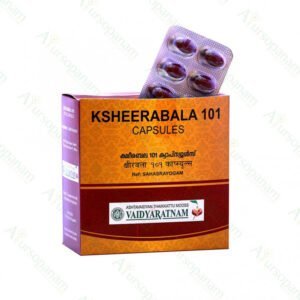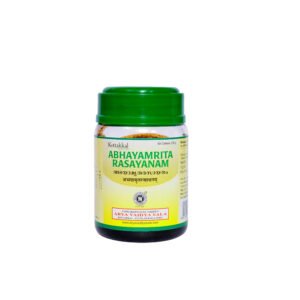Aswagandharishtam derives its name from ‘Aswagandha’ which is the Sanskrit name for Withania somnifera, a potent adaptogen and immunomodulator. Aswagandharishta combines Ashwagandhawith select drugs that are digestive in action and pacify aggravated Vata-Pitta elements in the body. It promotes nourishment, improves fertility, and bestows mental and physical well being.
Features & Benefits
- Aswagandharishtam is an aqueous extract of a combination of Ashwagandha (Withania somnifera,Musali (Curculigo orchioides), Vidari (Pueraria tuberose), Mustaka (Cyperus rotundus), Anantha (Hemidesmus indicus),Manjishta (Rubia Cordifolia), Chandana (Santalum alba),Trivrit (Operculina turpethum), Rajani (Curcuma longa) etc. in a mildly alcoholic base.
- The Aswagandharishtam formula is a powerful adaptogen. It calms the mind frayed by restlessness, panic and anxiety. Relieves mental stress and fatigue.
- It is excellent remedy for insomnia. Balances aggravated Vata and Pitta elements in the body. Induces calmness and tranquility in the mind and body.
- It modulates immune function. Builds the body’s natural defence to infection and disease.
- It improves functions of the brain intellect, memory and concentration.
- It facilitates efficient metabolism. It is effective in overcoming nutritional deficiencies, emaciation and fatigue.
- It improves fertility and sexual health. The arishta is instrumental in maintaining pristine quality of the Dhatus (body tissues), including the sperm and ovum.
- Aswagandharishtam has a sweet and mildly alcoholic base makes it palatable and quick in action.
Dosage and Instructions
Adult: 25-30 ml Aswagandharishtam twice or thrice daily after food.
Child: 10-15 ml Aswagandharishtam once or twice daily after food.
Suitable for all ages.
Key Ingredients
Ashwagandha (Withania somnifera)
Ashwagandha is commonly used for stress. It is also used as an “adaptogen” for many other conditions, but there is no good scientific evidence to support these other uses. Ashwagandha contains chemicals that might help calm the brain, reduce swelling (inflammation), lower blood pressure, and alter the immune system. The root contains steroidal compounds which include the lactones Withaferin A and carbon-27-glycowithanolide, known collectively as the Withanolides. The Withanolides are responsible for the varied medicinal applications of the herb. Winter Cherry also contains a fair amount of alkaloids including tropine, pseudotropine, isopelletrine, anaferine and saponins, which impart medicinal properties to the herb.
Musli (Curculigo orchioides )
Musli commonly known as Safed Musli is a rare Indian herb and also a popular magical folk remedy that has immense healing properties. Famed for its powerful aphrodisiac and adaptogenic effects, this herb is extensively used in all types of healing procedures, be it Ayurveda, Siddha, Unani, Homeopathy or Chinese medicines for boosting libido, curing sexual weakness, treating erectile dysfunction, impotence, relieving stress, reducing inflammation and many more.
Hareethaki (Terminalia chebula)
Popularly known as Indian walnut for its innumerable benefits or Indian Hog Plum in English, it is extremely valuable for its role in improving hair health. It is useful for treating scalp infections like dandruff, itching and hair fall. It also strengthens them from the roots, prevents breakage and loss of hair and bestows silky soft smooth hair. Chebulic Myrobalan is one of the three key ingredients in Triphala, a natural compound that provides overall support for digestive function and helps ensure that the digestive tract works at optimal levels. The Ayurvedic Pharmacopoeia of India has documented the use of the powdered herb in intermittent fevers and chronic fevers, anemia and polyuria. Chebulic Myrobalan can also be used to treat gastrointestinal and respiratory disorders
Manjishta (Rubia Cordifolia)
Manjistha or Indian Madder is considered to be one of the best blood-purifying herbs. It is mainly used to break down blockages in the blood flow and remove stagnant blood. Manjistha herb can be used both internally and externally on skin for promoting skin whitening. It helps manage acne and pimples by inhibiting the growth of acne-causing bacteria due to its antioxidant property.
Haridra (Curcuma longa)
Haridra, is also called known as Curcuma longa. The anti-inflammatory and antioxidant properties of Haridra assist in preventing the progression of diabetes-related changes in organs like the kidneys, retina, nerve cells and minute blood vessels in the body. The root of the herb, used either fresh or dried, has a host of medicinal benefits. It acts as a carminative and also enhances the complexion and skin tone. in addition, turmeric can be used to combat liver damage, respiratory disorders and ulcers.
Daruharidra (Berberis aristata)
Also known as Haldi, this vibrant yellow coloured spice checks the worsening of pitta doshas like jaundice. The powerful anti-inflammatory and antiseptic properties of turmeric help in evading infections and treats various skin conditions. Tree Turmeric is a revered herb in Ayurvedic medicine. Possessing antibacterial, anti-inflammatory, antipyretic and antiseptic properties, the herb is used as a cholagogue, stomachic, laxative and diaphoretic.
Yashti (Glycyrrhiza glabra)
It is also known as Yashtimadhu. It is beneficial in treating acid peptic disease. It reduces gastric acid secretion and inhibits the formation of peptic ulcers. It is also one of the world’s most widely researched herbs for its role in supporting the body’s normal digestive function. It is useful in hyperacidity, useful in peptic ulcer, useful in Gastro-Esophageal Reflux Disease (GERD).
Rasna (Alpinia Galanga)
It is also known as Alpinia Galanga. It is an Ayurvedic medicinal which is a rhizome grown in most of Southeast Asia and is used in cooking and homemade remedies. Rasnaplant is used in many Ayurvedic medicines in India, Tibet, Africa to help with inflammation, bronchitis, asthma, cough, indigestion, piles, joint pains, obesity and diabetes. The paste of the leaf is also applied externally to reduce swelling.
Arjuna (Terminalia arjuna)
Arjuna extracts have been widely used in Ayurvedic medicine. The bark of the tree has been used for several centuries for treating cardiovascular ailments. It has a host of other therapeutic benefits including treating asthma, hypertension and kidney stones. Arjuna, a deciduous tree native to India, can grow up to a height of 27 meters. The tree is also found in Myanmar and Sri Lanka.
Musta (Cyperus rotundus)
It is commonly known as common nutsedge. It is effective in gastritis, irritable bowel syndrome. Due to its breast purification property, it is used during postpartum care to avoid indigestion to the child. Nut Grass has a long history of medicinal use in the Ayurvedic system of medicine. Its benefits have been documented in the Charaka Samhita, one of Ayurveda’s prime texts. The herb also features heavily in medicinal texts of Chinese Traditional Medicine (CTM). in CTM, Nut Grass is credited with the ability to restore ‘Qi’, the natural patterns in which the body functions.
Trivrit (Operculina turpethum)
It is commonly known as turpeth. It is useful for easy purgation. Trivrit can be considered the best owing to its properties like strength, piercing and pungent nature. It is thus very useful in losing bodyweight. It is useful to get relief from worm infestation, constipation and healing infected wounds. Paste of trivrit consumed in the early morning for purgation.
Sariva (Hemidesmus indicus)It is also known as Sariva, is a semi-erect herb that has various phytoconstituents. These compounds add medicinal value to the herb. Sariva has been used in the Ayurvedic system of medicine for many years. It is used in the treatment of conditions like skin disorders, diarrhea, dysentery, eye diseases, syphilis, leukoderma, dyspepsia, chronic fever, leprosy, asthma, and others.
Chandana (Sanctalum album)
The addition of sandalwood or Chandan nourishes the skin by reducing pimples, acne marks, blemishes, suntan, dullness and excess oil from the skin. This potent herb pacifies Pitta doshas, cleanses the skin, reduces inflammation and effectively treats conditions like diarrhoea and piles.
Raktachandana (Pterocarpus santalinus)
Red sandalwood is a tree. The wood at the center of the trunk (heartwood) is used as medicine. Red sandalwood is used for treating digestive tract problems, fluid retention, and coughs; and for “blood purification.”
Vacha (Acorus calamus Linn)
Vacha is a traditional Indian medicinal herb, which is used to treat a wide range of health ailments, including neurological, gastrointestinal, respiratory, metabolic, kidney, and liver disorders. The root (rhizome) is used to make medicine. Despite safety concerns, calamus is used for gastrointestinal (GI) problems including ulcers, inflammation of the stomach lining (gastritis), intestinal gas (flatulence), upset stomach and loss of appetite (anorexia. The oil is used to treat stomach ailments and mental debility. Joint pains and aches resulting from rheumatism and arthritis are also relieved by Calamus oil.
Chithraka (Plumbago zeylanica )
It is a potent digestive medicine used for treating a host of ailments including indigestion, constipation, anorexia, abdominal distension, stomatitis, abdominal pain, etc. Imbued with digestive, caustic, stimulant and carminative properties, it eliminates harmful AMA toxins from the body which have accumulated due to malabsorption of food particles.
Shunti (Zingiber officinalae )
Due to its strong flavour, Ginger is an essential ingredient in many Asian cuisines. Its therapeutic benefits have been recorded in Ayurvedic and Traditional Chinese Medicine. Ginger is a potent anti-nauseatic and is beneficial in treating upset stomach. Gingerol and shogaol, active components of Ginger, suppress gastric contractions. Both the fresh and dried rhizomes of Ginger suppress gastric secretion and reduce vomiting. The compounds 6-gingerol and 6-shogaol have a number of pharmacological properties, including antipyretic, analgesic, antitussive and hypotensive properties.
Maricha (Piper nigrum)
It is commonly known as black pepper. It is a commonly used ingredient in the kitchen. Its properties include Antidepressant, Antifungal, Antidiarrhoeal, Anti-inflammatory, Antimutagenic, Anti-metastatic activity. Crushed pepper with honey relieves cold, and steam inhalation along with eucalyptus reduces chest congestion.
Pippali (Piper longum)
It is known as “Tridoshic” herb as it suits all body types. Thus regular consumption of pippali in suggested quantity can help you to immune your body to quiet an extent. Pippali has Anti-microbial, Anti-inflammatory activity. Consumption of pippali is said to exhibit antispasmodic action and hypoglycaemic effect, which is believed to lower blood sugar level. It is also reported to be the antagonist in respiratory depression. Also, due to its cooling post-digestive effect consumption of pippali is considered as a safe and effective option to avoid all sorts of digestive disorders.
Ela (Elettaria cardamom)
It is commonly used as Elaichi . It has a very good antibacterial and antifungal properties. It helps in reducing inflammation. Cardamon is often given the epithet ‘Queen of spices’ as it is used to flavor food in many countries. in addition, the herb has several health benefits. The German Commission E has indicated the use of Cardamom in dyspepsia and as a cholagogue, which promotes bile discharge from the system. The herb is also helpful in treating gum and teeth infections, throat congestion and kidney disorders
Twak
Twak is also known as Cinnamom verum. It is used for Neurological disorders, Cardiovascular diseases, Oxidative stress, Inflammatory disorders, Diabetes, Microbial infections, Cancer and other conditions extensively in Ayurveda.
Patra (Cinnamomum tamala)
Also called Tejpatta and Tejpat in English, Indian Bay Leaf is a spice as well as an Ayurvedic medicine. It stimulates the digestive enzymes, which helps to improve digestion of food and increases the bioavailability of the nutrients during the digestion process in the intestine.
Speciality: 100 % Natural. Purely herbal. Vegetarian.





















































Ratings & Customer Reviews
Reviews
There are no reviews yet.